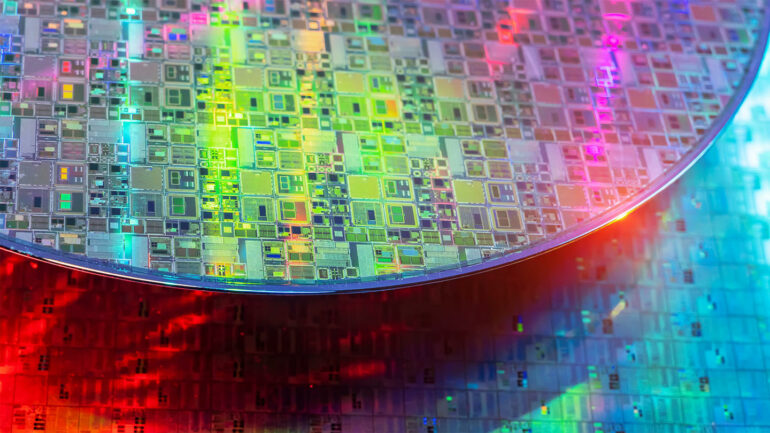Fashioned from the same element found in sand and covered by intricate patterns, microchips power smartphones, augment appliances and aid the operation of cars and airplanes.
Now, scientists at the U.S. Department of Energy’s (DOE) Princeton Plasma Physics Laboratory (PPPL) are developing computer simulation codes that will outperform current simulation techniques and aid the production of microchips using plasma, the electrically charged state of matter also used in fusion research.
These codes could help increase the efficiency of the manufacturing process and potentially stimulate the renaissance of the chip industry in the United States.
“Because devices with microchips are essential to our daily lives, how and where they are made is a matter of national security,” said Igor Kaganovich, a principal research physicist who leads the low-temperature modeling group at PPPL.
“Robust and reliable simulation tools that can accurately predict plasma behavior and shorten the manufacturing and design cycle of silicon chips could help the U.S. regain a leadership role in this field and maintain it for decades.”
Picking up the pace
One PPPL research effort involves reducing the time computers need to simulate microchip plasma reactors. This innovation would help private industry use more complex and accurate simulations widely and aid their drive to lower microchip costs.
“Companies would like to use simulations to improve their processes, but they typically are computationally expensive,” said Andrew Tasman Powis, co-author of the paper reporting the results in Physics of Plasmas and computational research associate at PPPL. “We are doing our best to counter this trend.”
Physicists usually want simulations to reproduce plasma as accurately as possible, generating virtual pictures that reveal the intricacies of plasma behavior with very fine details. That process requires algorithms, programs following a set of rules, that simulate plasma in very short time increments and in small volumes of space.
The catch is that such detailed simulations require powerful computers running for days or weeks at a time. That time frame is too long and too expensive for companies that want to use the simulations to improve their microchip manufacturing processes.
The researchers delved into plasma physics history to find already developed algorithms that might be able to shorten the amount of time necessary to simulate microchip plasma. The researchers found suitable algorithms from the 1980s; when tested, the algorithms demonstrated a capability to model microchip plasma systems in much less time and with only a small reduction in accuracy.
In essence, the researchers found that they could get good simulations even though they were modeling plasma particles within larger spaces and using longer time increments.
“This development is important because it could save companies both time and money,” said Haomin Sun, the study’s lead researcher and a former graduate student in Princeton University’s Program in Plasma Physics, based at PPPL.
“That means that with the same amount of computational resources, you can create more simulations. More simulations not only allow you to find ways to improve manufacturing, but also to learn more physics in general. We can make more discoveries using our limited resources.”
Related research led by Powis reinforces this possibility. In a paper published in Physics of Plasmas, Powis confirms that computer codes can generate accurate models of plasma particles while using virtual “cells” or small volumes of space that exceed a standard measure in plasma physics known as the Debye length.
This development means that the codes can in effect use fewer cells and reduce the need for computing time. “This is good news because reducing the number of cells could lower the computational cost of the simulation and therefore improve performance,” Powis said.
The algorithms can simulate so-called “capacitively coupled plasma reactors,” which create the plasma that engineers use to etch narrow channels in a wafer of silicon. These tiny passageways form the microcircuitry that allows the microchip to function.
“We are interested in modeling this process so we can learn how to control the properties of the plasma, predict what they would be like in a new machine, and then predict the etching properties so we can improve the process,” Powis said.
The team plans to test the algorithms further by adding the effects of different kinds of wall and electrode materials. “We want to continue to build confidence in these algorithms so we can be sure the results are accurate,” Powis said.
Recognizing and overcoming inherent limits
Another research effort focuses on errors that can creep into plasma simulations because of the inherent limitations of the simulation methods themselves, which model smaller numbers of plasma particles than are present in real plasma.
“When you simulate plasma, you would ideally like to track every single particle and know where it is at all times,” said Sierra Jubin, graduate student in the Princeton Program in Plasma Physics and lead author of a paper reporting the results in Physics of Plasmas. “But we don’t have infinite computing power, so we can’t do that.”
To get around this difficulty, researchers design code to represent millions of particles as one giant particle. Doing so simplifies the computer’s task, but also amplifies the interactions of the virtual mega-particles. As a result, a change in the proportion of particles moving at one speed versus how many are moving at another—a process known as thermalization—happens more quickly than it does in nature. Essentially, the simulation does not match reality.
“This is a problem because if we don’t address this issue, we won’t be modeling the phenomena as they actually occur in the world,” Jubin said. “And if we want to know how many electrons are moving at a particular speed, generating ions or reactive chemical species that interact with the materials used to make microchips, we won’t be getting an accurate picture.”
To compensate for these computational errors, the researchers found that they could make the mega-particle volumes larger and less dense, muting their interactions and slowing down the changes in particle velocities. “In effect, these results put boundaries on what is possible in microchip plasma simulations, point out constraints that we have to consider, and put forth some solutions,” Jubin said.
Jubin’s findings reinforce the notion that current simulation techniques must be improved. Whether because codes used today require small volume sizes and time increments that together slow simulations or because they produce errors based on computational requirements, scientists need new solutions. “This is actually a paradigm shift in the field,” Kaganovich said, “and PPPL is leading the way.”
The team included researchers from Princeton University, the Swiss Plasma Center at the Ecole Polytechnique Federale de Lausanne, India’s Birla Institute of Technology and Science, India’s Homi Bhabha National Institute, the University of Alberta at Edmonton, Applied Materials, Inc., and China’s Sino-French Institute of Nuclear Engineering and Technology.
More information:
Sierra Jubin et al, Numerical thermalization in 2D PIC simulations: Practical estimates for low-temperature plasma simulations, Physics of Plasmas (2024). DOI: 10.1063/5.0180421
A. T. Powis et al, Accuracy of the explicit energy-conserving particle-in-cell method for under-resolved simulations of capacitively coupled plasma discharges, Physics of Plasmas (2024). DOI: 10.1063/5.0174168
Haomin Sun et al, Direct implicit and explicit energy-conserving particle-in-cell methods for modeling of capacitively coupled plasma devices, Physics of Plasmas (2023). DOI: 10.1063/5.0160853
Provided by
Princeton Plasma Physics Laboratory
Citation:
Plasma scientists develop computer programs that could reduce the cost of microchips, stimulate manufacturing (2024, February 21)



